The real value of shade
August 1, 2019Shade does not only protect us from the sun, but it lowers the risk of skin cancer, reduces air pollution, and encourages physical activity. A new Israeli report revealed that providing shade can save thousands of shekels per person each year
It’s on those hot summer days when the sun towers high in the sky, dominating the better part of the day, and every outdoor activity becomes a sweat-inducing exertion, that only shade can bring some relief. A little bit of shade makes going outside significantly more tolerable; a walk with the dog, a visit to the beach, or taking a stroll. Most importantly, shade has many health benefits.
However, a lot of outside areas in Israel do not have efficient shade. Recently, Israeli researchers found that the advantages of shade are also reflected in the savings of the country’s budget and that the lack of shade causes considerable economic costs.
The new report was funded and accompanied by the Ministry of Health and the Ministry of Construction and Housing, and was written by Prof. Nir Becker and Or Neviot, researchers at the Tel Hai Academic College.
“Many publications speak of the lack of shade in Israel,” says Dr. Amiel Vasl, deputy director of the Ministry of Construction and Housing’s policy department and one of the initiators of the report. “We saw that in the professional world there is no shortage, but rather an excess of guidelines for shading, and all of them say that shade is a good thing and a lot of it is needed.” However, he says, these works do not examine the potential economic benefits of shade. “No one talks about how much money shade could actually save,” he says.
Shade for good health
To answer these questions, the researchers performed cost-benefit analyses for shade provision in urban areas. For this purpose, they calculated the costs involved in creating different types of shade: Infrastructure for planting and maintaining trees, artificial shading (e.g., pergolas), and erecting porches (colonnaded avenues in front of buildings).
Subsequently, these costs were compared to the economic health benefits of shade in the urban environment. “In financial terms, the budget savings show to what degree shade prevents morbidity and mortality. In Israel, a large part of the costs of medical treatments is covered by the state. Therefore, if the population is healthier due to shade, the country saves money,” says Becker.
One of the most important health benefits of shade is the reduction of skin cancer, a disease often caused by excessive sun exposure without protection. In 2015, 1,674 patients were diagnosed in Israel with melanoma, the most common type of skin cancer, and 185 died from the disease. According to the World Cancer Research Fund (WCRF), Melanoma is the 19th most common type of cancer in both men and women, and in 2018, 300,000 new cases of melanoma were reported worldwide.
Another widely overlooked benefit of shade is that it encourages people to exercise. Insufficiently shaded roads or pedestrian areas, on the other hand, have the opposite effect. Whenever there is not enough shade, people prefer driving instead of walking or riding their bikes, which automatically results in less exercise time.
This reduction has health implications. Data indicates that 31 percent of the world’s population does not reach the recommended minimum level of physical activity, which is 30 minutes of moderate-intensity exercise five times a week. Frequent and regular physical activity has many health benefits, including significantly lowering the risk of cardiovascular diseases (such as a stroke), type 2 diabetes, colon cancer, breast cancer, and obesity. At the same time, regular physical exercising strengthens the immune system, reduces mental stress and depression, and helps people to quit smoking.
In addition, trees, which produce natural shade reduce the concentration of particulate matter up to 2.5 microns (PM2.5), which is one of the most common and dangerous air pollutants. These microscopic particles can quickly enter the human body through the airways, reach the lungs and the circulatory system, and cause respiratory as well as cardiovascular diseases; they can even accumulate in brain tissue. The leaves of the trees naturally absorb a certain amount of these particles, thus reducing the health risks they might cause.
“Over the past decade, dozens of research papers, articles, and policy documents have been published, demonstrating how the lack of shade in public spaces in Israel harms public health. There even have been urban design exhibitions aiming to raise awareness of this specific problem,” explains Dr. Aviad Hadar, one of the initiators of the report. “It is important to understand that the presence of shade in the urban area has a crucial impact, either consciously or subconsciously, on the decision to leave the car at home and instead use less or non-polluting alternatives, especially in city centers that suffer from heavy air pollution due to car traffic.”

Make people walk
The researchers found that the cumulative benefit from providing shade could reach thousands of shekels per person each year. According to the significant health benefits that have been quantified economically, the cost of creating shade is a profitable investment. The financial return from shade creation projects is in the tens of percent per year.
For instance, 230,000 shekels were invested for the construction of a 200-square-meter artificial shading project at a school. Thanks to the shade, 30 percent of schoolchildren became more physically active at school, which improved their health. The annual benefit for the child is NIS 105, and a total of NIS 105,000 for the entire school. According to these figures, in less than three years, the investment will pay off.
“Our findings show that the greatest economic benefit comes from making adults walk,” says Vasl. Most of the guidelines, he says, focus almost exclusively on shade for children. They ignore the importance of daily physical activity as a contribution to the health of the adult population, particularly the elderly population. “It’s a target audience that we ignored until now, and a vital use of shade that needs to be focused on,” adds Vasl.
The report also addresses the need to complement natural sun-shading with artificial shading in order to optimize solar protection in places where planting trees might not be a practical solution. Trees have many health and aesthetic benefits, but in terms of ideal shade provisions, they naturally have some limits and drawbacks. It takes eight years for trees to grow to a size that can provide maximum shade coverage, and even then, most of them are not sufficiently taken care of. An example of the successful use of artificial shading is the long roof that shelters the many people who enter and leave the Haganah train station in Tel Aviv every day.
The last type of shade that is discussed in the report is shade provided by buildings – maintenance for this kind of shade is negligible, and its effect is immediate. Thus, the report recommends that the feasibility of providing shade through buildings be more closely examined.
Agencies that bear the costs of shade might not reap the benefits
Apart from the various health benefits examined in the report, shade has a decisive impact on lowering a city’s temperature. Future projections indicate an increase of around 2-3 degrees in average daily temperatures in Israel by 2050. According to a recent study, residents in the Tel Aviv Metropolitan Area might experience extreme heat stress for eight months out of the year. On the other hand, optimal climate planning in the urban environment that includes the expansion of shade-giving infrastructure may reduce the thermal load by 50 percent.
So if the economic and health-related benefits of shade are so prevalent, why is there a shortage of it in Israel? Perhaps the main reason is that the government bodies that bear the cost of implementation, specifically the Ministry of Construction and Housing, are not the ones who reap the benefits. These benefits would be seen in the National Insurance Institute and the Ministry of Health. Therefore, it may be necessary to approach budgetary issues concerning shade provisions on an inter-ministerial level. There is no doubt that increasing the amount of shade is an essential step to more pleasant, healthier, and economical summer days in Israel.
This ZAVIT article was also published in The Jerusalem Post on 07/28/2019.







